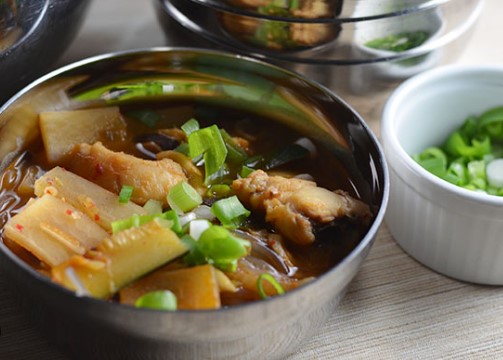Indulge in the savory delights of Spicy Monkfish Stew (Agujjim), a heartwarming dish that beautifully showcases the rich and sweet flavors of monkfish. Known for its meaty texture and delightful taste, monkfish creates a hearty and satisfying stew that delights the palate. This recipe strikes a balance between two iconic Korean ingredients—gochujang and doenjang—combining them to perfection for a harmonious blend of spicy and savory goodness. As you prepare this delightful stew, you have the flexibility to adjust the proportions of gochujang and doenjang to suit your preference, allowing you to tailor the flavors to your liking. Experience the warmth and comfort of this delightful monkfish stew, a dish that epitomizes the heartwarming essence of Korean cuisine.
INGREDIENTS:
- 2 tablespoons doenjang or gluten-free doenjang
- 1 tablespoon gochujang or gluten-free gochujang
- 1 tablespoon gochugaru
- Salt
- 6 cups Anchovy Stock (here), or store-bought seafood broth
- 1 small zucchini, cut into 2-inch slices
- 1 small sweet onion, sliced
- 1 small daikon, cut into 2-inch pieces
- 5 ounces fresh shiitake mushrooms, thinly sliced
- 1 to 1½ pounds monkfish, cut into 2-inch chunks
- 1 (14-ounce) package of mung bean or sweet potato noodles, cooked according to the package directions
- 1 scallion, chopped, for garnish
PREPARATIONS:
- In a stockpot, mix together the doenjang, gochujang, gochugaru, a pinch of salt, and the anchovy stock and set the pot over medium-high heat. Once the seasonings are dissolved in the stock, add the zucchini, onion, daikon, and mushrooms and bring up to a boil. Reduce the heat to low and simmer for 10 minutes.
- Add the monkfish and simmer gently for about 15 minutes, or until the fish is cooked through.
- To serve, divide the noodles among 4 large soup bowls and ladle the stew over the noodles. Garnish each serving with scallions.
YIELD:
- Serves 4
TIPS:
- Customize the proportions of gochujang and doenjang to achieve your preferred level of spiciness and bean-paste flavor.
- Look for mung bean, sweet potato, cellophane, glass, or Chinese vermicelli noodles at Asian grocery stores.
In conclusion, Spicy Monkfish Stew (Agujjim) stands as a testament to the art of achieving a harmonious balance in culinary flavors. The dish captures the essence of Korean cuisine, marrying the delightful flavors of monkfish with the fiery allure of gochujang and the comforting depth of doenjang. As you savor each spoonful of this hearty and soul-soothing stew, you’ll find yourself immersed in the warm embrace of culinary excellence.
Preparing Spicy Monkfish Stew presents a journey through the rich tapestry of Korean flavors. The combination of gochujang, gochugaru, and doenjang creates a symphony of spicy, sweet, and savory notes that dance on the taste buds. The freshness of zucchini, the sweetness of onions, the earthiness of daikon, and the umami-richness of shiitake mushrooms further elevate the dish, offering a tantalizing medley of textures and flavors.
The star of the show, monkfish, stands proudly as the meaty centerpiece, delivering a delightful sweetness that pairs perfectly with the robust seasonings. The simmering process allows the fish to soak up the flavors, resulting in tender and succulent chunks that are infused with the essence of the stew.
As you serve the Spicy Monkfish Stew, the fragrant steam rises, filling the air with the irresistible aroma of hearty goodness. The vibrant colors of the vegetables, combined with the richness of the stew, create an inviting presentation that promises a feast for the senses.
One of the charms of this dish lies in its versatility—you have the freedom to adjust the proportions of gochujang and doenjang to match your taste preferences. Whether you crave an intense spiciness or a more pronounced bean-paste flavor, the recipe adapts to your desires, ensuring a personalized culinary experience.


